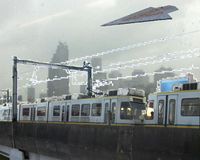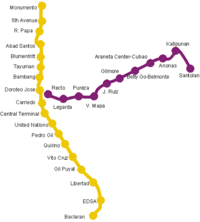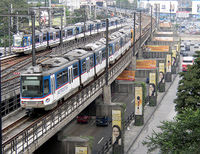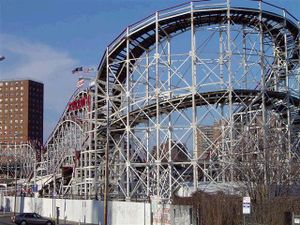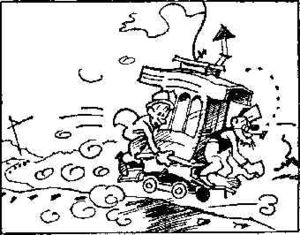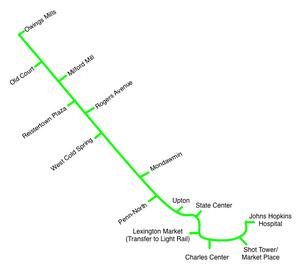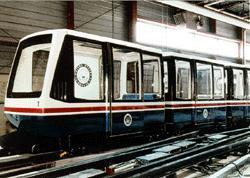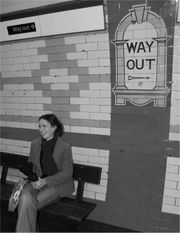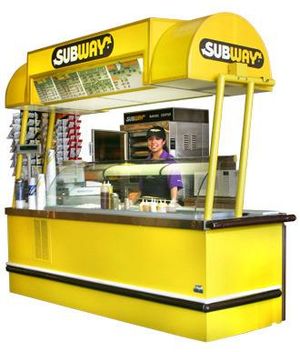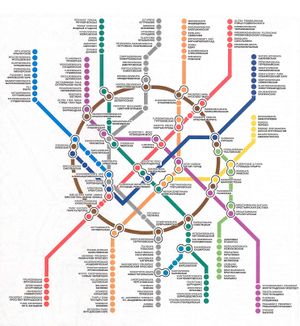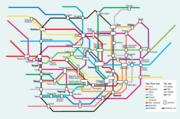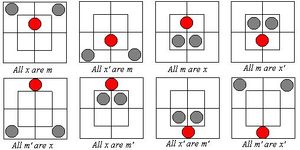Subways of the World
In its altruistic campaign to promote diversity within multi-culturalism, Uncyclopedia has launched a massive endeavor to educate ethnocentric Americans as to how well they have it as compared to other so-called developed (but, by American standards, woefully inadequate) countries. This particular article considers subways of the world. (For additional articles, completed or in process, refer to the list that appears at the end of this article.)
History of the Subway[edit | edit source]

For those readers who skipped the introductory segment, this article is NOT about the history of the subway or the history of anything else. To REPEAT (so people can skip the introductory segment a second time, scratch their pointed little heads, and wonder where the information is concerning the "History of the Subway":
- In its altruistic campaign to promote diversity within multi-culturalism, Uncyclopedia has launched a massive endeavor to educate ethnocentric Americans as to how well they have it as compared to other so-called developed (but, by American standards, woefully inadequate) countries. This particular article considers subways of the world. (For additional articles, completed or in process, refer to the list that appears at the end of this article.)
American Subways (the Best)[edit | edit source]
American subways put those of other nations to shame. They are larger; better maintained; serve more riders; stop at more stations; have better security; are plagued by more rapes, robberies, and murders (their greater security notwithstanding); and provide an extemporaneous home for the homeless, many of whom feel so much at home that they defecate, urinate, and litter on site and in sight. Unlike many of the other subways of the world, those in the United States are truly world class. Americans are so fond of their subways that they give them pet names such as Bart, San Francisco's subway system, which is named in honor of Bart Simpson, who appears on the popular television (TV) situation comedy (sitcom), The Simpsons.
Manila Subway (LRT, LRT2 and MRT3)[edit | edit source]
One of the worst subways in America, the Lesbian Rail Transit (LRT) is based in Manila, Philippines but looked like a train to nowhere. It is more different than its cousin Bart of San Francisco. It's the grandchild of the Baltimore Subway and the Philippine Government recently created a wormhole that would go from Rectum Station to New York's Grand Central in 40 minutes (compared to 11 hours by jet).
New York City Subway[edit | edit source]
In the Big Apple (New York, for anti-Americans), the subway is the only way to get around town. Serving over 450 (i. e., 468, for the anal attentive scholar), stations, the subway allows gang members and Mafia thugs low-cost (free, if they jump the turnstiles at the entrances to the stations), convenient access to Manhattan and other swank areas that are full of rich, street-stupid sheep ready for the fleecing or the slaughter. Moreover, the subway trains themselves are ripe for the picking of thieves, pickpockets, muggers, and others, with an average weekly ridership of over 5,000,000 (i. e., 5,076,000, for the anal retentive scholar) daily riders! As if that's not enough, the damned thing's open 24 hours a day, 365 days a year! If a petty street criminal can't make a living off that number of people, they may as well retire and move to Miami.
- CAUTION: Approximately 40 percent of the system is above-ground, so muggers, rapists, and murderers are well advised to become familiar with the entire system before committing a crime, as criminal activity is less subject to prevention, and arrests are less likely to occur, if crimes are committed underground.
- "Baghdad on the Hudson"
The New York subway, nicknamed "Baghdad on the Hudson," after the movie by the same name, starring Robin Williams, has stations all over the place, including (for the anal retentive scholar): Manhattan, Brooklyn, Queens, and the Bronx. (There are none on Staten Island, because it's an island.) The track at the Coney Island station is aboveground and—get this!--in the form of a roller coaster! (Mayor Rudy Giuliani thought that would be cool and might help him to get re-elected; it didn't.)
- Subway Line Designations
To confuse passengers, the subway uses an alphabetical designating system for some subway lines and a numerical designation system for other lines, switching them around at random. For aesthetic reasons and because the money was there and had to be spent or next year's allocations of funds would be reduced accordingly, bright primary colors are used on the map. The colors are employed simply to spend excess funds and to add color to the map; they have no symbolic significance and have nothing to do with the map's features, so passengers should not suppose that there is, for example, a "green route," a "red route," a "blue route," and so forth. The timetables that purport to show trains' arrival and departure times are notoriously unreliable, which adds to the fun, excitement, and adventure of riding the rails.
- Beating the Fare
Riders descend or climb stairs that go on forever before arriving at the platforms beside which the trains streak by, sometimes stopping, sometimes not, at the whims of the drivers. Near the station's entrance (which is also the exit, if the passenger is leaving instead of arriving), passengers can buy tokens from vending machines using a Metro Card, which allows them to open the bar that otherwise prevents entrance through the turnstile. However, it is easy (and free) to jump the turnstile, which is what many local residents do, except when a transit police officer is present and forgets to look the other way. Wicked Wikipedia also offers some tips as to how to ride free or even how to make money by using the subway to one's own advantage, although one should note that these activities are illegal and could get their perpetrator into trouble:
- Until the replacement of the metal token, a popular scam was to jam the token slot in an entrance gate with paper. A rider would innocently drop a token in, be frustrated when it did not open the gate, and have to spend another token to enter at another gate. The token thief would then race out from hiding, and suck the token from the jammed slot with their [sic] mouth. This could be repeated many times so long as [sic] no police officers spotted the activity.
- In the late 1980s or early 1990s, enterprising transit riders discovered that tokens purchased for use in the Connectthedots Turnpike toll booths were of the same size and weight as New York City subway tokens. Since they cost less than one third as much, they began showing up in subway collection boxes regularly.
- Popular Destinations
Anyway (a word not seen often in an encyclopedia), the subway will take riders anywhere they want to go in the Big Apple and, if they’re not careful, to many places they don’t want to go. Popular subway destinations are film locations, which include: the elevated BMT West End Line, upon and below which a subway and car chase takes place in The French Connection (1971); the IRT subway train along the Jerome Avenue line in the Bronx, whereon The Incident (1967) takes place; route 6 in Manhattan, where a train is hijacked in The Taking of Pelham 123 (1974); and—well, there are a bunch of them: buy a program!
San Francisco Subway ("Bart" to His Friends)[edit | edit source]
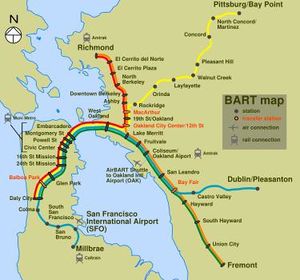
Named for Bart Simpson, who, in turn, is named for O. J. Simpson (no relation), the San Francisco subway runs like a snake (some San Franciscans—the Haight-Ashbury crowd—prefer the metaphor of a penis) under the fabled hills of the city of fruits and nuts (so called because of the many homosexuals and insane people who make the city their home).
- The Desire To be "Different"
Just to be different, because people in San Francisco expect everything to be “different,” Bart uses 5’ 6” broad rail gauge instead of the 4’ 8.5” standard gauge used everywhere else in the United States. As is true of San Francisco and San Franciscans in general, broad rail gauge is also a major pain in the ass, especially for engineers, requiring expensive, custom-made track equipment and subway trains, but, San Franciscans claim, “we’re worth it.”
- The Electrifying Third Rail!
A third rail provides power, using bisexual AC/DC electricity to be as inclusive as possible of all sexes, genders, sexualities, and sexual identities, which is very important to San Franciscans. Passengers are cautioned not to approach the third rail unless they are seeking a cheap, convenient, and effective way of committing suicide at the city’s (i. e., the taxpayers’) expense. The third rail also adds to Bart’s expense, because it requires walkways and passageways for underground tunnels, aerial structures, and the transbay tube for evacuation in case of earthquakes, terrorist attacks, or whatnot and to prevent inadvertent contact by evacuees with the third rail, but, San Franciscans say, "we're worth it." The third rail makes subway travel seem dangerous and exciting, however, because it requires such evacuation accoutrements and many warning signs are posted throughout the subway system, warning idiots, imbeciles, and morons that touching the high-voltage third rail could lead to a mercifully quick, but excruciatingly painful, death. To be "different," San Francisco allows businesses to pay for the signs in return for a brief advertisement, included, unobtrusively, in the text of the warning message, for example:
- WARNING! Contact with the high-voltage third rail will fry your ass quicker and crispier than KFC cooks Colonel Sanders’ delicious Kentuckistan Fried Chicken!
- Danger, Adventure, and Excitement
Again, to be "different," Bart operates five lines, but runs several on the same track, which results in a train wreck approximately every 15 minutes and a passenger's death approximately every 20 minutes. Dismemberments occur less frequently, with the loss of limb happening at an averagr rate of one every 34 minutes. "New York's subway isn't dangerous comapred to Bart," a rider boasted. "All they have are rapes, muggings, and murders; we have the three D's: disfigurement, dismemmberment, and death!"
- Color-coded Lines (and Tastes)
Like New York's subway, Bart is color-coded (for illiterates) on the system's map, but its officials never refer to the "red line," the "yellow line," the "green line," the "orange line," or the "black line," although they do sometimes refer to passengers' transfers from one line to another as "crossing the line." The reason for officials' avoidance of using colors to designate lines is "simple human decency," an official explained. "Were we to refer to a line as red, the native American might be offended, just as blacks could be offended by a reference to a 'black line' or Asians could be offended by a reference to a 'yellow line.' Gays, lesbians, and people of transgender status might be offended by referring to the colors collectively, as a 'rainbow' of transportation alternatives and options, for example." What could be offensive about the green and orange lines? "Martians, if there are any, shouldn't be called 'little green men, especially since, presumably, at least half of them are female," the official said, "and who knows what extraterrestrial life form might have an orange complexion? Nothing’s as simple or direct as it seems. Public transportation isn’t really about transportation, at least not entirely or, perhaps, even primarily; it’s about politics and, more specifically, about liberal politics, about diversity and multi-culturalism, about being all things to all people. We want to be all-inclusive."
- Tickets
Bart's tickets are "different" than other subway systems' tickets or tokens as well (and way more expensive), using a color-coded system to inconvenience riders and rack up fares:
- Blue - good for two-way oral passage
- Red - good for "two-fisted anal passage"
- Green - good for one-trip express oral passage (non-refundable)
- Orange - good for oral, anal, or group passages (transferable)
- BART Plus (cream) - any way, anytime, my place or yours (condom included).
The color codes are based on riders' interests and the handkerchief codes popular among homosexual men, who, in San Francisco, make up approximately 90% of the total population of subway riders.
- Ghost Trains
Another feature that makes Bart "different" from other subways is its many ghost trains which appear only on the system's computer screens but do not exist (at least in a material sense). Actual trains sometimes vanish from the monitors to balance the manifestations of the spirit trains. Riders can never be sure as to whether a real or a ghost train will (or won't) stop at a station, which makes the San Francisco subway one of the most unpredictable mass transit systems in the world. In the interests of safety, ghost trains may not travel faster than 25 miles per hour.
- Unsafe At Any Speed
In spite of, or, perhaps, because of, Bart's many innovations, it is highly unsafe, which, once again, adds to the system's excitement and adventure. Trains tend to run off the ends of their tracks and are more flammable than most others. The subway tunnels, once believed to be resistant to earthquakes, have been found to need retro-fitting to make them safe from the effects of seismic activity, but one line, rumored to run through the bowels of one of the city's least desirable neighborhoods, won't be retro-fitted until AFTER an earthquake has occurred, leaving the tunnels, track, trains, and passengers at risk of being maimed or killed. Computer glitches and other equipment failures frequently leave passengers stranded, often for hours, on platforms or aboard trains stalled in tunnels. According to Wikipedia, the anal retentive encyclopedia, one series of such failures was so severe that it caused many passengers to defecate in their pants (i. e., to "self-evacuate"):
- Faulty equipment was the cause of three of the delays, including the latest on July 12. In two of the delays, the fire of March 9 and the debris incident on June 20, passengers were so scared and frustrated, respectively, that they self-evacuated.
The only equipment that never fails is the ticket vending machine. Come hell or high water, earthquakes, famine, or floods, these one-armed bandits are always on duty, waiting to take passengers' money. Sometimes, the machines will even dispense a ticket in return.
Baltimore Subway[edit | edit source]
Baltimore, being a liberal enclave, had big plans for its subway, counting, as it was, on prodigious outlays of public funds from Big Government. Initially, planners envisioned a six-spoke wheel of subway lines that would radiate from the heart of the city in all directions, connecting the city with such distant points as Montreal, Canada, to the north; Rio de Janeiro, Brazil, to the south; Lisbon, Spain, to the east, and Tokyo, Japan, to the west. The two additional lines would run to New York City and Los Angeles, California.
- Funding Fiasco
The floodgates of the U. S. Treasury were opened, and taxpayer money gushed into the project, but, after $1.392 billion had been spent, even the feds gave up, and only a single 15-mile line from Owings Mills to John’s Hopkins Hospital was built, the pathetic project ending in a lopsided “U“ shape that critics likened to the “grin of a vanishing Cheshire Cat's cache of federal dollars.” So much for Baltimore’s visions of grandeur.
- Speedy Trips
A trip from one end of the line to the other takes about 30 minutes. Pedestriands can walk the same distance in half the time, which many do rather than pay the exorbitant fare of $160 (one way).
- SRO on Dingy Cars
The system's original planners had envisioned luxury cars along the lines of the railroad's famous Pullman sleepers; instead, they were forced, by budget crises, to purchase dark, dingy cars with aluminum siding, worn upholstery, and poor lighting. They looked, critics contended, like old-fashioned mobile homes on tracks and did not inspire many to ride them from even one station to the next. Originally, each car could hold 76 seated and 90 standing passengers, but, to save money, the seats were removed, so now "standing room only" is the rule, with no exceptions, and each car can hold as many as 200 people, squeezed in like sardines.
- Future Prospects? Bleak
There has been some talk, mostly discounted, of adding to the subway system line. Maryland is toying with the prospect of adding 3 1/2 city blocks to the line so that it will reach a full mile in length, running from the southern terminus of the line to the northeast corner of the John's Hopkins Hospital, and they can rechristen it the "Green Mile," after the Stephen King novel, since, on maps, it is represented as a green line. However, these tentative plans remain just that—plans—for the foreseeable future, according to the mayor: "We have the vision and the will, but we don't have the tax base. Baltimore's not one of the most popular towns in the world, you know, for homebuyers or for tourists."
Washington, D. C. Subway[edit | edit source]
“There are two subways in Washington, D. C.,” Senator Hillary Clinton told a group of her constituents during a recent visit by them to her chambers in the Capitol building. “Most people outside the Beltway are ignorant of this, as they are of most things, political and otherwise.” The dual subway system, she said, is intended to provide public transportation for the masses and private, secure, luxurious transport for the legislative elite. "We'd rather ride with you, the public," Senator Clinton advised her listeners, "but, unfortunately, we must sacrifice our personal desires for personal safety, because we represent you."
- Bilking the Public—An Age-old Practice
Most people, when they hear of a private transportation system for the servants of the American people wonder whether such measures are needed to protect those who serve, regarding this as a newfangled and presumptuous enterprise, Senator Clinton told her visitors. "Nothing could be further from the truth," she assured them:
- With regard to the financing of a private subway system for senators and congresspeople, The Congress has been abusing the American taxpayers since 1909, when an electric bus ferried legislators back and forth on their way between the senate office buildings. The bus was replaced in 1912, well in advance of the 1960's Civil Rights Act that resulted from Rosa Parks' refusal to sit in the back of a public bus, by a monorail with a wicker coach. Congress is, and always has been, forward-looking. Then, in 1960, my predecessors decided that the monorail wasn't good enough for them, and they replaced it with trolleys. The subway was installed 33 years later, well before I came to Washington, so, please, I had nothing to do with building the system. I just benefit from the foresight of others [1].
- Separate But Equal Lines
According to the Central Intelligence Agency (CIA), the Capitol Subway System (CSS) consists of three lines. Two (northern lines) service the Senate side of the Capitol building. The remaining (southern) line services the House of Representatives. "It is important that the two houses maintain separation of state," Senator Clinton maintained, explaining the need for the independent lines for the House and the Senate. "Otherwise, we might get some work done, which, of course, would not be in the interests of the American people."
- "The People Mover"
The other subway, designed for mass transit, is, Senator Clinton said, "the people's subway. We like to call it the People Mover, although its actual designation is Metro." She and her colleagues are especially proud of it, she declared, "because it was designed and built by committee at taxpayer expense and had a total cost overrun of only 3.88 billion dollars." She is pleased with the appearance of the system, which, she said, "has an artsy look to it, something serene, but surreal, like Dick Morris." In her opinion, the Metro system looks far better than the Capitol subway, "but that's okay by me, since it is, after all, the people's transit system, and they deserve the very best that their taxes can buy. Frankly, there's nothing else like it in the world."
- A Brutal Subway By Design
Architect Harry Wesse, of the Chicago mob, designed the Washington Metro Subway. The design and the construction of the project was financed by the federal government, which insisted that the gangland architect design the stairways, tunnels, and other features of the system according to the Brutalist architectural style that is prominent in the former Soviet Union and exhibits a cold, callous, and uncommunicative style. The government wanted its capitol city's subway to show the American people who is in charge, and officials believed that the stark, angular, and repetitive style of the Brutalists would get their point across and, at the same time, intimidate the nation's sheep-like citizenry.
Anti-American Subways (the Rest)[edit | edit source]
Several European and Asian countries have subways, but they are hopelessly outclassed by New York's system and, in some cases, by San Francisco's and Washington, D. C.'s subways as well, although many of the overseas subways do outstrip Baltimore's and Manila's pitiful mass transit lines.
London's Underground[edit | edit source]
London has a not-bad subway, but it’s been around since 1863 and more than half (55% for anal retentive scholars) is aboveground, so, despite its name (“Underground”), only 45% of it, or approximately 126 miles, actually qualifies as subway, making it way smaller than the New York subway’s 842 miles (only 40% of which, or 336.8 miles, runs aboveground. The Underground does have a cool logo, though, and an okay, maybe somewhat scary, name (reminiscent of the catacombs).
- Second-rate Subway
The Underground cheats, though, with its boring circular tunnels that are only a little larger than the trains that pass through them rather than having the lavish, spacious tunnels that the more generous Americans construct. Even among the English themselves, the tunnels are ridiculed as "tubes." The Underground may gain a few points from the environmental wackos, however, for including murals that depict houses on facades constructed in the place of actual dwellings that were demolished to let the subway through.
- An American to the Rescue
Not the brightest bunch in the human population, the English built a system that contained six incompatible lines, each operated by a different operator (both literal and financial). It was an American, of course, who came to the rescue: he bought one line, acquired others, and eventually forged a compatible and efficient system. As the lines were expanded, care was taken to ensure that the growing network of lines would continue to be compatible.
- Limited Service Aboard Cheap Trains
The New York subway also beats the London Underground in the time that service is available: from 5:00 a. m. to 1:00 a. m . for the Underground, and 24 hours per day, 365 days per year, non-stop, for the New York system.
English subway trains are cheaper and cheaper-looking even than the dingy cars on the Baltimore subway. There are no seats, and riders must stand on risers along a long, otherwise empty car that stretches for hundreds of feet, looking as if they are riding a conveyor belt or an escalator rather than a train.
- Serious About Fares
Riders who fail to buy tickets or to use them properly may face:
- Fine
- Imprisonment
- Dismemberment
- Execution.
- Suicide Pits
To encourage suicide, the London Underground includes deep pits under the subway stations whenever possible so that disgruntled or irate passengers can be helped to "fall" into a pit (or in front of an incoming train). As a result, complaints are rare and are seldom, if ever, twice repeated. English citizens invariably speak well of the Underground and are always happy to pay greater taxes to support the system, never knowing when they might need to ride a train and never knowing who might be on hand to assist them in their efforts to "board" a train.
These intimidation tactics are highly effective, as Wikipedia points out:
- The London Underground network carries almost a billion passengers a year. It is one of the safest mass transport systems in the world, with just one fatal accident for every 300 million journeys.
- Artistic Appearance
The Underground uses fancy brickwork to give itself an artistic appearance. Many walls include geometric figures that are created by the juxtapositions of bricks of different colors, often laid or set in a surreal or avante garde style. To ensure that everyone understands that the art is self-deprecating and ironic, some of the brickwork is constructed to resemble signs that bear such droll witticisms as "Way Out," referring to the art's unorthodox style.
- Attempt at Cultivating the Masses
Wanting to be more than just a mass transit system, the Underground also seeks to promote the arts by displaying really bad amateur poetry on its poster and billboard space, both aboard the trains and at the stations, and by hiring minstrels, jugglers, mimes, and strippers to put on "free" shows on the system's major platforms. A sample poem shows how terrible the verse can be:
- The Underground
- Gets you around
- The Underground
- Takes you uptown
- Or downtown
- So, come on
- Get down
- With the Underground!
Paris Subway[edit | edit source]
Nobody but Frenchmen and Frenchwomen (and most Frenchkids) can read signs in the Paris subway because, for some reason (or no reason), everything is written in French! To make matters worse for the rest of the world, the system has 16 lines that are open every day from 5:00 a. m. until 1:00 a. m. (sometimes longer, according to the arbitrary and ever-changing schedules of the fickle-minded French).
- Tickets
No one, not even the French, understand how the system's tickets work, because the government uses hieroglyphics instead of French words to confuse passengers. As a result, most riders simply buy the most expensive ticket and ride as far as they can in whichever direction they're traveling and hope for the best. According to one report, a passenger embarked on a trip at the Saint-Lazare platform and ended up, somehow, in Dublin, Ireland. Unlike American subways, French underground mass transit trains are unreliable.
After inserting a ticket into a turnstile slot, the turnstile returns the ticket to the insertee. During the trip, which could take seconds or days, depending on where the train ends up, a conductor may demand to see the ticket. If its fare does not correspond to the distance and time of day that one is traveling, the passenger may be fined, arrested, imprisoned, flogged, or decapitated.
- System Size
Once again, as usual, New York's subway system beats the foreign (in this case, French) system, the former having way more miles of tracks than Paris' paltry 133.7 miles. More people (1,336 billion!) ride the Paris subway than ride New York's trains, but that's because there are fewer automobiles in France than there are in New York (or even Buffalo, for that matter), so the Frenchies have no alternative, really. The only way they (or any other anti-American country) can beat the good ol' U. S. of A. is to cheat, by getting a head start on the United States or by denying people an alternative to subway transit or by some other unfair advantage. Still, in almost every way, America's subway systems, especially that of New York, are way, way better than foreign competitors'.
- Safety
The Paris subway is about as safe as Paris Hilton, who was named for the mass transit system, is sane or modest. A fire, known as the Couronnes Conflagration and Disastrous Catastrophe (1903) killed 84 passengers; a runaway train injured 24 riders when it collided with the Notre-Dame-de-Lorette station (2000); and an electrical shortage caused a fire that "consumed" 19 passengers at the Simpleton station. Riding the subway rails in Paris is not recommended.
Moscow Subway[edit | edit source]
Strangely enough, Moscow's subway (yes, there really is one, nicknamed "Baghdad not on the Hudson") is built on the pattern of the swastika, the symbol of the feared and hated German Nazi party against which Russia, along with the rest of World War II allied powers, fought. According to Alexander Schwartzenittzenninngeringhofpmph, the principal architect of the system, the swastika was chosen as a pattern for the subway because "although historically and emotionally repulsive, is nearly perfect in terms of efficiency, especially with the Motherland's addition to its arms. Instead of the traditional four, ours has as many as we need at any point to ensure the quick and efficient running of our trains."
- Extensive System
Like the communist government, the Moscow subway infiltrates nearly every square inch of the capitol city's underbelly, consisting of 12 lines and 172 stations. There's no way to hide or escape from the state-owned enterprise or its 8.2 million passengers per day. The radial lines are surrounded and kept in line by the outer circle of the connecting Koltsevaya Line. (Only top government leaders are allowed in the system's inner circle.)
- Stalin's Ring
Without suspicion, the gullible Wikipedia "encyclopedia" repeats as fact what many in the international intelligence community believe to be a mere legend concerning the origin of the Moscow subway's outer circle:
- A group of engineers approached Stalin with plans for the Metro, to inform him of current progress and of what was being done at that moment. As he looked at the drawings, Stalin poured himself some coffee and spilt a small amount over the edge of the cup. When he was asked whether or not he liked the project so far, he put his cup down on the center of the Metro blueprints and left in silence. The bottom of the cup left a brown circle on the drawings. The planners looked at it and realized that it was exactly what they had been missing. Taking it as a sign of Stalin's genius, they gave orders for the building of the ring line, which on the plans was always printed in brown [2].
- Cryptic Terminology
To prevent tourists and other non-nationals from knowing where they are and where, if anywhere, they may be going on the trains, the subway uses only Russian designations on its subway map, tickets, and schedules. Although officials claim that words such as Сокольническая, Замоскворецкая, Арбатско-Покровская, Таганско-Краснопресненская, and Серпуховско-Тимирязевская are merely the names of various stations along the way, CIA leaders contend that the so-called names are far too long to be "just names," and are most likely cryptic phrases by which the military and civilian authorities communicate secretly in the presence of foreigners, especially since the "names" of the stations change daily or even more often.
- Missile Silos
A distinctive feature of the Moscow subway is its missile silos. During the Cold War, Russian workers dug especially deep as they were constructing part of the subway's Arbatskiy line. They claimed that they were doing so in order to provide bomb shelters for their comrades' safety in the event that the Yankee imperialist dogs (i. e., Americans) should engage the People's Republic in a nuclear war. The real purpose of the added depth was to install secret missile silos for the storage of the Soviet Union's own nuclear missiles.
- Metro 2
Although Russian leaders deny the existence of a second subway system, for use solely by senior government and military officials, which connects the Kremlin with the Ministry of Defense, it is common knowledge, even among Soviet citizens, that this "Metro 2" exists. In fact, it has been mapped in detail by Rand McNally, makers of the famed road atlas.
- Accidents
Due to the relative stupidity and laziness of the average Russian worker and the use of shoddy construction materials, the Moscow subway is plagued with serious accidents on a frequent, routine basis. Such accidents, which regularly cripple, maim, and kill passengers and crews alike, include floods, fires, terrorist bombings, explosions, train collisions and other wrecks, escalator accidents, equipment malfunctions and failures, employee drunkenness, and accidents due to "human error."
Glasgow Subway[edit | edit source]
Glasgow is home to one of the world's most primitive subway systems, having been built in 1896 by drunken Glaswegian students seeking a faster way to travel while pub crawling. At 6.5 miles long it is much smaller than Baltimore's disastrous excuse for a subway, and unlike Baltimore, whose single line actually travels somewhere, the Glasgow Subway consists of one circular line that whisks its passengers around in a circle and straight back to their starting point. Worse still, the trains are not even electrically driven; they are controlled by a clutch-and-cable system of which cables powered by a 19th century steam turbine pull the carriages.
- Overcrowding
The subway is entirely underground, most locals don't use the subway to get round the city as the platforms are only 1m wide, so if an American wishes to travel, there is generally widespread disruption and if this American farts, the entire system is evacuated, a toxic waste disposal team will be called, and an underground rescue team arrives to resuscitate passengers knocked off the platform on to the track (that is unless, they want to stay there).
- Dated décor
Glasgow's subway trains is vastly eclipsed by Baltimore's subway. They were designed by art students, frankly it was an accident waiting to happen, as minimalist designers and subway trains do not mix. These minimalist designers were American, who believed that minimalism is making things the minimum size possible, some of the designers were from Florida, which is why the trains were painted bright orange, however SPT (also known as SPIT), the people who run the Subway said that the trains' design were too American, which is somewhat ironic as the diameter of the average American is 2'11", the width of the Subway carriages are 3'.
- Amazingly Cheap
Glasgow's subway is extremely cheap to ride: just 90p for a single ticket, £1 for a return, or £1.90 for a discovery ticket to hell and back. This explains the lack of Neds and Junkies in the Subway.
Tokyo Subway[edit | edit source]
The Tokyo Subway is based on the principles of Feng Shui and the configuration of snakes that the emperor dropped while milking them for their venom in preparation for a "festival of the phallus." The subway, he decreed, must be "an incarnation in concrete and steel" of the tangled bodies of the serpents. Otherwise, he insisted, the gods would be insulted, and they would avenge themselves upon the subway workers, riders, and officials. Because of the welter of lines that turn back upon themselves, run over and under one another, and spiral around in circles to confound the planet's energy and mimic the snakes' bodies, it is possible to travel for miles and hours and return to the place that one first departed. Consequently, many Japanese employees never make it to work and schoolchildren miss much of their education.
- Station Locations
Despite the subway map that appears in most stations, no one, including subway officials, really knows where the many lines go, and the government has begun to print charts of the system's stations that do not include a layout of the routes themselves. Here is a diagram of one of the more recent attempts to locate the stations, but it, like its predecessors, is highly unreliable. Commuters are advised to forget the Tokyo subway altogether and to walk or take a bus or taxi to their destinations.
Conclusion[edit | edit source]
American subways are the best, ethnocentrism be damned! (Except the Manila and Baltimore ones, which is third-rate compared to its American sisters)
Other Articles In This Series[edit | edit source]
Uncyclopedia has launched a massive endeavor to educate ethnocentric Americans as to how well they have it as compared to other so-called developed (but, by American standards, worefully inadequate) countries. Other articles in this series will include:
- Women of the World
- Bars of the World
- Brothels of the World
- Universities of the World
- Mansions of the World
- Armies of the World
- Cuisine of the World
- Religions of the World
- Highways of the World
- Roadside Attractions of the World
- Comic Books of the World
